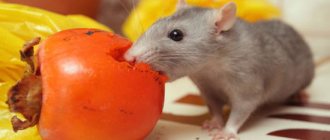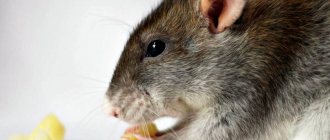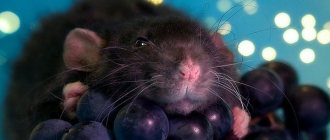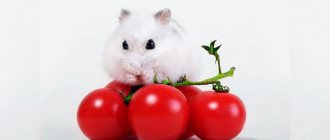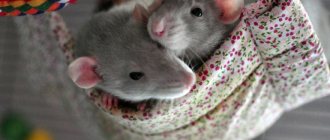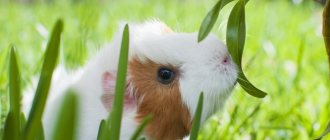According to the latest data from zoologists, rats are second in number only to insects. And some scientists believe that there are even more rodents. Their numbers are growing steadily, regardless of the wealth of the country they have chosen to live in. In Moscow, according to the most approximate estimates, there are forty rats for every city dweller, including migrant workers. The vitality of the latter is explained by their omnivorous nature (we will discuss what rats eat a little later) and the speed of reproduction. But an equally important factor is their adaptability, intelligence and intelligence. Thanks to these qualities, rats quite confidently fit into the category of pets, sometimes showing enviable devotion to the owner and the ability to take into account his wishes. And now about everything in more detail and in order.
Features of rat nutrition
Coming up with a list of what rats eat is almost impossible because they eat everything. The only exceptions are absolutely inedible things, although even wires and polyethylene can be chewed and partially swallowed. However, for all their indiscriminateness, rats treat food in the wild quite reasonably. In the wild, they never overeat, so they do not become obese. If a rat is lucky enough to get a high-calorie piece, it eats less food. If what rats eat is low in nutrition, the amount consumed increases accordingly. If there is a lack of some minerals or vitamins in their body, these rodents look for foods with a high content of the necessary substance.
It should be noted that rats (domestic or wild - it makes no difference) eat all the time. If you forget to feed your pet for at least two days, it will die. Therefore, in the wild, animals are constantly in search of food, and, if possible, they create reserves.
What do rats look like: photo
Rats.
Description and characteristics
Name: Rats Lat.:
RattusClass: Mammals - Mammalia Order: Rodents - Rodentia Family: Mouse - Muridae
| Habitats: | everywhere except Antarctica |
| Lifestyle: | nocturnal, active, most semi-arboreal |
| Peculiarities: | pests of farms, stocks, disease carriers, experimental animals |
Rats are common mammals, primarily nocturnal and crepuscular inhabitants. Their average size is 400 grams and 37-40 cm. The tail is usually equal to the length of the body, sometimes even reaching 1.5 of this figure.
The shades of the fur are most often dark, less noticeable. They are gray-brown, black or dark brown. Although there are decorative subspecies with bright unusual shades or light coat colors.
Are you afraid of rats?
Not really
Compact and nimble animals swim well and climb trees easily. Some species do not like heights, although they can climb vertical surfaces.
These rodents are highly intelligent. They live in packs, protect each other and their territories, and transmit information. They are frequent participants in all kinds of research, they have developed dexterity and intelligence. Follow the link to read 20 more facts about rats that will surprise you.
Geographical distribution
Rats easily adapt to living conditions.
Rats are highly adaptable. They tolerate low temperatures, swim well and climb rocks and trees. Rodents are predominantly nocturnal, settling where they have enough space and food.
Rats can travel on ships and thus, according to many historical legends, spread across all continents. They live almost everywhere except Antarctica. Some are widespread, while others are very narrow and only on some continents.
Nutrition and lifestyle
Rats need regular food and plenty of water. You need about 25 grams of food per day, and about 30 ml of water. Rodents do not store much. However, they are unpretentious and omnivorous. Their taste preferences change slightly depending on the geographical location and time of year. In general, dietary preferences are:
- seeds;
- vegetables;
- fruits;
- grains;
- succulent stems;
- food waste;
- livestock feed;
- small rodents;
- amphibians;
- worms;
- shellfish;
- insects.
Taste preferences of wild rats
Despite all the promiscuity of the creatures we are considering, there are some foods that rats like more than others. Thus, if there is a choice between wheat and wholemeal flour, preference will be given to the latter. Although if the grain is thoroughly wet or mixed with odorless vegetable oil, attention will be divided equally between both “dishes”.
Sweets are what rats (both tame and free) eat with special pleasure. Moreover, it doesn’t matter how nutritious the food is, sweetened with saccharin will do. So in this case, it is not the calorie content (and, accordingly, the survival factor), but the taste sensation that is important.
The following fact is noteworthy: what a white rat eats can be categorically rejected by its wild relatives. For example, it is well established that laboratory albinos prefer food with the addition of anise and butyric acid, while ordinary rats diligently avoid it. Moreover, if experimental cubs are fed only food with such additives, and then offered a treat without them, they will not hesitate to change the imposed diet. Scientists believe that the attachment of white rats to these “flavors” is genetic, innate.
Nutrition of newborn rats
Naturally, immediately after birth, little rat pups feed exclusively on mother's milk. Therefore, it is necessary, first of all, to take care of the mother’s correct diet. After about a month, your pets can be gradually transferred to regular, proper, nutritious food.
There are still cases when, for some reason, a mother cannot feed her baby, so there is no way to do without human help.
You can replace mother's milk with dog or goat milk. If this is not possible, then purchase ready-made mixtures at a pet store and feed the babies according to the scheme given in the instructions.
For the first half month of life, pups need to be fed every 2 hours throughout the day. After this period, the number of feedings should be reduced and done every 4 hours.
During the month, the baby can be gradually switched to adult food. First, introduce your pet to fruits and vegetables. Then add grains to your diet. Don't forget about fermented milk products, which will help normalize intestinal function.
What to feed your pet
The diet of a tame animal must be calculated and diversified, because ornamental rats eat everything, like their wild relatives, but they move less, and therefore they can become obese. And if they lack some element, they will not be able to find it on their own. Pet stores sell balanced foods, when developing which manufacturers took into account what domestic rats eat and what they need most. However, you should not limit yourself to only such products if you want to have a healthy animal in the house, and not regularly take it to the veterinary clinic. It is necessary to give your pet boiled meat, seafood and tripe. By the way, even kitten food is suitable. The diet must include vegetables (carrots, cucumbers, turnips, cabbage), berries and fruits. Instead of multivitamins, you just need to regularly feed your pet rat with greens - lettuce, dandelion and clover leaves, dill. Remember what rats eat in the wild. Cereals, that's right! The grain can be given in its usual form, or it can be sprouted. Oat and wheat sprouts are especially useful in this regard - in winter they are a valuable source of vitamin E.
What food is dangerous
The domestic rat, although considered an omnivore, reacts negatively to some foods. Here is their list:
- spinach, beets, raw vegetables.
- Sweets, chocolate.
- Tofu.
- Unripe bananas.
- Alcohol, carbonated drinks.
- Fried, excessively fatty foods.
- Spoiled products.
Many plants and their extracts are also dangerous:
- carnation.
- Geranium.
- Fern.
- Aloe, Kalanchoe.
- Agave.
- Lily of the valley, tulip.
- Tomato leaves.
To avoid the harmful effects on the body of an ornamental rodent, it is necessary to prevent its contact with these plants.
Medicinal products
No matter how hard you try to protect your pets, it is very possible that they will still get sick. In this case, you need to be more careful about what rats eat: some foods will help them overcome illness. So, if your animal is already “aged”, so that it does not suffer from arthritis, add a little garlic and ginger to its food. As a preventive measure for all kinds of viral infections, you can give onions, prunes, cranberries, and strawberries. If your pet needs antibiotics, before injecting him with medicine, it is better to feed the patient bananas, eggplants, raspberries, plums, and the same garlic and onions. You can feed the animal with echinacea decoction.
Recipes for preparing poison for rats with different baits and poisons
Generally speaking, recipes for poisoned baits for killing rats and mice can be very diverse; it is only important to adhere to the rules noted above when choosing a food base and observe the proportions indicated in the instructions for using the corresponding poison (so that the rat does not notice the danger).
Here are several ready-made recipes that have been tested many times in practice and in most cases give good results when fighting rats:
- 100 grams of minced meat (no matter meat or fish), 850 grams of crushed bread and 50 grams of Zookoumarin;
- 870 grams of crushed bread, 100 grams of onions fried in vegetable oil, and 30 grams of Ratindan;
- 890 grams of crushed bread, 100 grams of vegetable oil and 100 grams of Rat;
- 700 grams of crushed bread, 150 grams of mashed potatoes, 50 grams of vegetable oil and 30 grams of Ratindane;
- 990 grams of cool wheat or oatmeal porridge and 10 grams of Rat.
For these recipes, poisons are taken in the form of powders (dusts) - they are sold in hardware stores.
The ingredients of all recipes are simply mixed thoroughly and placed in portions of about a teaspoon in places where rats can easily find them.
On a note
There are also known folk recipes for poison for rats based on milk and alabaster, as well as those containing an infusion of chilibukha, an emetic nut, as an active ingredient. However, they are significantly less effective compared to poisons based on blood anticoagulants (which include Zookoumarin) and Krysida.
In addition, it should be borne in mind that today there are many ready-to-use poisoned baits for rodents on sale: in the form of dough briquettes, solid granules, poisoned grain, etc. It is often easier (and safer) to buy ready-made preparations than to make poisoned baits on one's own.
It is also useful to read: Methods of fighting rats in a private home
Vegetables, fruits and other foods that are given little by little
When discussing what rats eat (we are talking exclusively about pets), we should discuss not only the quality of the food, but also its quantity. So, you need to know what food can harm your pets if they receive it regularly and in large doses. Among such products are:
- Pears. They are fixed, so give no more than once every two weeks.
- Grape. It can “pull” fermentation along with it.
- Beet. Diarrhea is almost guaranteed, but if you didn’t experience it the first time, you can give it, because it’s useful. Just don't overdo it!
- Eggs. Be sure to cook it, it is better to buy quail and offer it no more than once a week.
- Sour cream. Only as a treat, little by little and with the same frequency.
What Do Pet Rats Eat?
Often, a huge number of owners of pet rats make a lot of mistakes when feeding their pets, since all kinds of waste from the human table become food for rodents.
In most cases, domestic rats do not refuse such nutrition, but in this case, after some time, the animal develops various pathologies of organs and systems. This is why creating a rich and healthy diet is vital for these animals.
Daily diet
The daily diet of a domestic rat should consist of the following products:
- greens: dill, cilantro, all kinds of lettuce, parsley, radish leaves, dandelion, celery, plantain, clover, wheat sprouts, oats and other grains;
- boiled vegetables: potatoes, turnips, cucumber, cabbage;
- fruits: all types of fruits are allowed, but citrus fruits (lemon, orange, tangerine, etc.) and pomegranate should be included in the diet carefully and in small portions, as they can cause severe allergies;
- berries: any variety is allowed; raspberries are a special treat for these rodents;
- dairy products: any types of fermented milk products (cottage cheese, kefir, yogurt, sourdough, etc.);
- grain products: wheat, oats, corn, oat flakes. In winter, the diet should be enriched with barley, millet and sunflower grains;
- nuts: all varieties are acceptable, with the exception of almonds, which should be completely excluded from the diet, or given in small quantities and with extreme caution;
- soy food: any variety and in unlimited quantities;
- meat: occasionally a rat can be pampered with a small amount of boiled pork, beef, chicken, turkey. You can replace meat products with kitten food or low-fat boiled bones;
- fish: you can eat fish in unlimited quantities, but your attention should be focused exclusively on low-fat varieties;
- eggs: quail eggs are the most beneficial for rodents, but this product should be included in the diet no more than once every 7-10 days.
Important! When feeding rats apricots, peaches and other stone fruits, be sure to remove the stones, as they contain cyanide, which even in small quantities is hazardous to the health of rodents.
Treats are an integral part of the diet of almost any mammal, and domestic rats are no exception. However, you can occasionally pamper your pet with only a few products.
Only suitable for these purposes are:
- ham;
- sausage;
- low-fat milk;
- low-fat sour cream;
- hard cheese;
- crackers;
- sweets with low sugar levels;
- juices
The basis of the rodent's diet should be grain products and nuts , they should be used daily and in unlimited quantities. Fruits, boiled vegetables, animal products and lactic acid products are used as bait.
In a balanced diet, bait from fruits and vegetables should predominate (every day or every other day, 30-40 g per individual), bait from animal products is used no more than 2 times a week (15-20 g), but lactic acid products should Use no more than once a week (1 tablespoon).
During illness
During the period of various diseases, the rat’s diet should not be radically changed, since a balanced diet is exactly what the animal’s body, weakened by disease, needs.
But in order to maintain your pet’s health in difficult times, its food must be supplemented with products with a high content of highly active substances. Only they are able to have a gentle effect on the body, as well as have a beneficial effect on the basic processes of restoring the health of the animal.
In order to have an antibiotic effect on the rat’s body, the following are best suited:
- bananas;
- raspberries;
- plum;
- eggplant;
- garlic;
- onion;
- yellow mustard;
- Echinacea tea (instead of drinking water).
Learn about the types of pet rodents and how to choose and care for a jerboa, hamster, guinea pig, prairie dog, gerbils, dormouse, chipmunk, and Chilean squirrel.
The following have antiviral properties:
- onion;
- cranberry;
- plum;
- prunes;
- strawberries
Some of the most common diseases in rodents are arthritis and various malignant and benign tumors. Therefore, in order to have an antitumor effect on the animal’s body, broccoli must be present in its diet.
Well, in order to reduce the manifestations of arthritis, as well as prevent the development of this disease, the rodent should be given garlic and ginger weekly.
Did you know? Rats began to be actively used as a decorative animal in the first half of the 19th century.
During pregnancy and lactation
Pregnancy is a special time in the life of every mammal. During this period, the mother’s body needs additional amounts of various nutrients, without which it is difficult to imagine the favorable development of the fetus.
Therefore, in order to support the mother rat’s body during pregnancy, her food must be enriched with additional sources of protein, vitamins and minerals, as well as compounds harmful to the development of the fetus must be eliminated.
In the first half of pregnancy (10-14 days):
- the most useful products for the animal will be: chicken or turkey meat, poultry cartilage, apples, fresh willow branches;
- The consumption of: liver, grain sprouts, broccoli should be limited;
- You need to completely exclude: garlic, onions, tomatoes, bell peppers.
In the last stages of pregnancy (after 14 days):
- the most useful products for a rodent will be: chicken or turkey meat, poultry cartilage, apples, cottage cheese, fish, nettle leaves;
- You should limit your consumption of: egg yolks, cucumbers, lettuce;
- You need to completely exclude: garlic, onions, grapes and raisins.
Poisonous grass
So, we figured out what rats eat. But you also need to have an idea of what is dangerous for them. Especially if your pet has the opportunity to move freely around the apartment, and you are a fan of home gardening. If he can only get potato, cherry, tobacco, and euphorbia leaves from your hands (that is, you just need to check that the animal does not eat them), then he can gnaw indoor flowers without your knowledge. The following house plants are poisonous to rats:
- dieffenbachia;
- indoor feces;
- azalea;
- begonia;
- ivy (any variety);
- amaryllis;
- cyclamen.
The worst thing is that the rat cannot be forbidden to eat flowers, or hide them so that he cannot get to them. If you have such plants in your house, you will have to keep the animal in a cage.
Common types of rats
Rats have entered people's lives very closely. They are primarily pests, but also pets. Some species of rats are experimental rats, and many laboratory studies are carried out on them.
Have you kept decorative rats?
Not really
Pets
A decorative rat is an excellent option for a pet. They don't take up much space, but are still affectionate and cute. Rodents are easy to train, cunning and inquisitive.
There are a number of breeds that may differ from each other in size, color and even character.
Standard. Animals up to 500 grams in weight and 20 cm in length. The shade can be plain light, gray or black. Rarely, but tricolors occur.
Rex. An unusual breed with curly hair and even a mustache. The animals are active and responsive to affection. Breeding is no different from other breeds.
Sphinxes. The same name for hairless breeds is also found among rats. Sick, active and very exotic. Such rodents live shorter than other ornamental ones.
Dumbo. They can be of different colors, but are distinguished by large, round ears. Otherwise they can be similar to any other breeds.
Types of decorative rats.
Wild rats
These are representatives of rodents that are pests. They live in nature, but often climb into areas even in people’s homes, harming them.
Gray rat
This is the pasyuk, which is the most common species. Most often they are gray-red, but they can also be dark. They are smart and quick-witted, often entering houses and apartments.
Gray rat pasyuk.
Black rat
These representatives of rodents are not always black. May be lighter. Black rats are slightly less common than the previous ones. Not aggressive, they attack only if they are in danger.
Black rat.
Earth rat
She's a water vole. A very omnivorous and voracious rodent, capable of doing a lot of harm, but preferring to live on the slopes of reservoirs. Comes to people in case of migration or severe famine.
Earth rat.
Other types
There are a large number of rats that live on different continents and can only be found in zoos. Thus, the Gumby hamster rat is one of the representatives of this species and is very useful. There are marsupial rats that bear children like kangaroos.
Types of rats.
Prohibited
Some foods are generally contraindicated for these animals, although not as dangerous as herbs. Of the things that rats absolutely cannot eat, blue cheese should be mentioned first. And in general, any cheese is fatty and salty, and therefore leads to obesity in pets. But “blue” can even poison your pet.
Green bananas impair the digestibility of starch. These fruits should only be given to rats when they are ripe.
The green parts of potatoes contain solanine, a fairly strong poison for rats. When cooked it is less dangerous, but when raw it can be fatal.
Raw beans and peas are almost guaranteed to cause flatulence in the animal and, as a result, tympany.
Smoked meats, lard (especially salted), fried meat, sausage - your pet will definitely do without all this. The consequences of regularly feeding such products can be very sad.
Chocolate, candy, cakes and pastries should also be excluded from the rat’s diet. If you want to treat her to something tasty, give her a piece of fruit.
Basic rules for feeding rodents
Even considering the fact that rodents eat almost everything, feeding them everything is definitely prohibited. The diet for a rodent must be well thought out and balanced. Carbohydrates should be in larger quantities - at least 60%, rats need about 25% of the total amount of food, proteins - a little, about 10%.
Special food for rodents
Basically, you need to feed rodents food specifically designed for them. It is sold in every specialized pet store. You can also prepare a mixture of grains for your pet yourself. Everything in purchased food is already balanced, so ready-made food is most convenient for feeding a rodent. But these products are not suitable for all animals; it happens that the animal does not like the composition, most of the ingredients are not suitable for him. The owner may not like the high cost of feed.
If you couldn't find the mixture from the store, prepare it yourself. Of course, it is not always possible to add everything you need to the grain mixture; it can be difficult to obtain. Alternatively, you can combine large feed and grains. The latter will perfectly dilute the nourishing large food, and such food will interest the rodent. It can also be mixed with special food.
Vegetables, fruits and greens
Vegetables and fruits contain a large amount of healthy vitamins and are low in calories, which is suitable for animals prone to obesity. A large amount of vegetables, fruits and herbs are contraindicated for rodents, as this can cause problems with the pet’s digestion and health in general. These products should be given to the animal as a supplement to the main food, and they should be given every day or every other day. In this case, you need to look at what your pet likes and how much he eats his favorite food. On average, a rat can be given about 10 grams of vegetables and fruits per meal.
Animal protein
Rats are not vegan, like a guinea pig, for example, and these pets need animal proteins for development, growth, strengthening the immune system and generally for normal existence. It is permissible to feed a rat with stone meat, fish, eggs, seafood, they can even be given premium dog and cat food.
These products are given to adult rodents 1-2 times every seven days. Young individuals who are not yet six months old need animal protein in larger quantities than adult individuals, since they need it for full development.
Dairy products
It has been established that cottage cheese, kefir, yogurt and, in general, all fermented milk products are very healthy. These products contain lacto- and bifidobacteria, which ensure the normal functioning of the animal’s intestines. They also serve as a source of calcium. They can be given to the animal regularly, without restrictions, rats love this food.
If you discover that your pet is lactose intolerant, you should stop giving him dairy.
Rats need fermented milk products containing small amounts of sugars and various additives. You should not give rodents completely low-fat foods.
Treats
Many owners of these pets treat them with various treats. But you should always remember that you should not give your rodent a product that can harm it. You cannot treat the animal with sweets, alcoholic beverages, chips, sausages and other products harmful to it. Treat your pet to crackers, nuts, fruits and not very sweet cookies. But you shouldn’t pamper your pet too much with this. Stores also sell special treats for rodents, which contain vitamins and microelements the animal needs.
Other food
Some rat owners treat and feed them other types of food, not just those listed above. The rodents are given food for the children and everything they eat themselves. Indeed, if these products do not contain anything harmful or dangerous, why not treat your pet? But on the other hand, there is no need to feed the rat everything; it can get by with food that is healthy for it. But if you really want to give something to your pet, do it infrequently - no more than twice a week, and it is better to treat the animal with natural products without additives or seasonings.
Is it possible to give porridge to a rat?
There is no exact and uniform opinion here. Porridges will not harm your rodent, because they contain fast carbohydrates that your pet does not really need. When you decide to feed your rat porridge, you do not need to cook the cereal. You can cook it just a little, soften it, or simply pour hot boiled water over it, without adding salt, sugar, seasonings, or oil.
Danger to humans
Rats are carriers of dangerous diseases, including:
- plague;
- typhus;
- tularemia;
- toxoplasmosis.
Rabies in rats is another serious problem. A rabid rat can attack a person or any animal, infecting it when it bites.
In addition, rodents cause serious economic damage by eating crops and food supplies, spoiling non-food products, and damaging electrical networks (which can lead to fires). Rats living in houses spoil property and food and pose a health hazard. Therefore, having noticed the first traces of rat presence, it is necessary to urgently take action.
Feeding a sick rat
From the very beginning of the appearance of a rodent in the house, you should decide on the name of the products, which, if necessary, can be replaced with others. The disease is common to many people and rats are no exception.
If your pet is unwell or has a sudden allergic reaction, you need to think about a special diet:
- Infection. A set of products for infectious diseases should consist of eggplant, plum, banana and mustard leaves. Don’t forget to add raspberries and cranberries during this period. Onions and garlic will also come in handy.
- The appearance of neoplasms (tumors). This problem is not uncommon in domestic rodents, then for prevention and treatment, the existing set of food products should be replenished with broccoli cabbage. She is best able to cope with this disease. Do not forget that cabbage should be either boiled or steamed.
- Joint disease (arthritis). This disease can very often be observed in domestic rodents. Only a veterinarian can help with this, but ginger root and a clove of garlic will help ease your pet’s joint pain.
Reproduction and offspring
Rats are one of the most prolific mammals. They breed throughout the year. Over the course of a year, a female can bear from 2 to 7-8 offspring. Depending on the species of rat, the litter ranges from 2 to 20 pups. Pregnancy lasts about 3 weeks, after which naked, blind and deaf babies weighing about 5 g are born. After about 2 weeks, the rat pups' eyes open, and after another 10 - 15 days the mother stops feeding them milk, as they are ready for independent life.
Brood
Portion sizes and diet
When selecting products for the rats' menu, it is important not only to determine what is possible and healthy for these animals, but also how to feed them correctly - the number of meals per day, in what portions.
Many veterinarians recommend giving your white pet food twice a day. It is advisable to have meals at the same time. Your pet should eat the largest amount of food in the evening. If you follow all the recommendations, you will be able to avoid problems with the functioning of the digestive system.
Note! Adults should be fed twice a day. But females during pregnancy should eat more often, up to 4-5 times. Small rats are also often fed to strengthen their bodies and improve their immune system.
In no case should you change your diet suddenly; a new product must be introduced gradually, in small portions. The pet must get used to it and try it thoroughly. In addition, this will help his digestive system get used to new food better and prevent the occurrence of disorders in its functioning.
It is imperative to strictly observe the size of food portions that pets eat at one time. One serving should be 70-80% of the total weight of the animal. For females during pregnancy and adult males, the size of one serving increases to 100%.

